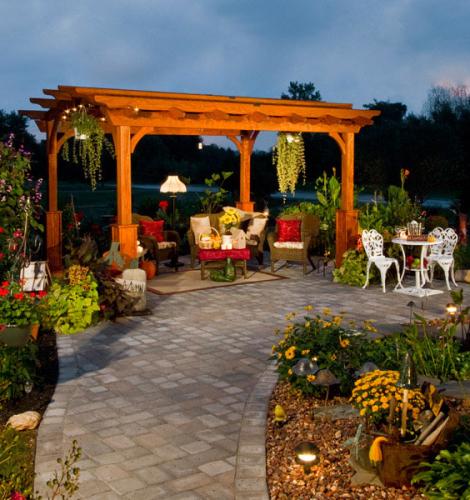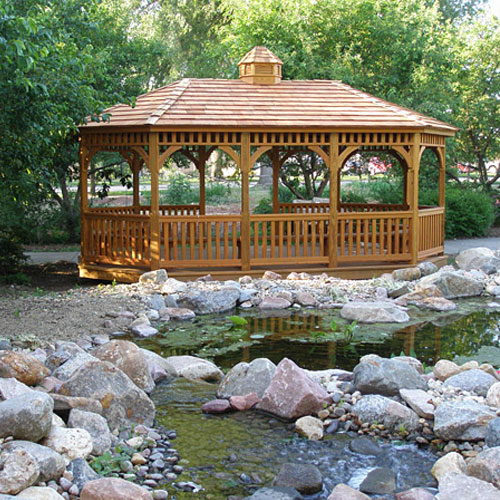
Outdoor living is becoming increasingly popular in the United States with pergolas, pavilions, and gazebos. These structures offer protection from the rain, privacy from neighbors, comfortable living space, and relaxing areas to enjoy nature. That said, outdoor living spaces do so much more than create shade in hot weather and shelter during a light rain.
Pergolas, pavilions, and gazebos will add market value to your property. Ultimately, if you end up selling your home, it can become a feature that motivates a buyer to quickly close the sale.
So, what is the difference between these three structures, and how do you get the most out of one?
Pergola
Pergolas are an outdoor garden feature that add visual interest to your landscaping or patio. They're most commonly used to support heavier vines and to shade walkways, decks, or sitting areas. Does this sound like an arbor? The two structures are similar. Unlike arbors, however, pergolas have corner posts supporting an open, roof-like structure.
Always containing vertical columns, pillars, or posts, pergolas can be free-standing or positioned against a building for support. Larger than an arbor, this structure is identified by an open roof with a crossbeam or latticed top. It does not keep out the rain, making it perfect to grow woody vines and provide light shade.
Many cultures have incorporated pergolas into their gardens. Ancient Egyptians used pergolas to grow figs, and in Italy, it’s still common to see wine grapes growing on these structures. Although pergolas are informal structures, historic examples still exist in Italy and England.
Pergola Add-Ons
A popular pergola trend is to stretch or drape weather-resistant outdoor fabric between the crossbeams of a pergola to create a canopy. There are thousands of colorful prints and solids sold by the same companies that manufacture outdoor pillow and cushion fabrics. Choose a heavy-duty shade material so leaves and weather-related debris blow off.
Pergolas are also utilized to support climbing plants, which distinguishes the structure from pavilions and gazebos. Since pergolas have strong pillars, this is your opportunity to add heavier climbing plants to the garden and fill in the gaps between the crossbeams. These plants are known for growing on pergolas and thrive in three different climates:
-
Bougainvillea. Grows 30 feet in length. Plant this vine in a pot if you don't live in subtropical climates. Each year, it will quickly grow back if you move it indoors during the cold months. Bougainvillea needs sun.
-
Cape Honeysuckle. Grows 40 feet or more. This bush withstands high winds and requires little water once the roots are established. In warm climates, the Cape Honeysuckle shrub blooms fall to spring.
-
Wisteria. Grows 7 feet the first year. You may wait a few years to see the first blooms but Wisteria can withstand -20 degree weather. It's a deciduous vine with a woody trunk that grows well on your pergola but must be kept away from buildings with siding.
If you like the idea of a pergola but need a covered roof for protection against rain and harsh sun, a pavilion or gazebo might be the right choice for your property.
Pavilion
Pavilions distinguish themselves from pergolas with a solid, finished roof constructed of metal, asphalt, or cedar shingles. With added protection from harsh weather, pavilions can function as a room for shelter, seating, events, exhibitions, sports and games, relaxation, and any other need you may have. The sides can be open or hung with curtains for privacy or increased shade. Portable and permanent pavilion options are available on the market.
Also seen at state and municipal parks to rent or reserve for large picnics, parties, and outdoor events, pavilions stand alone, away from other buildings on a property. They can be an empty multi-use shelter or filled with picnic tables and seating. Although utilitarian in function, pavilions don't need to be ugly or boring. One of Canada's most famous pavilions was designed by Frank Lloyd Wright and Francis Conroy Sullivan for the Banff National Park (Alberta) in 1911.
Gazebo
Gazebos are a freestanding structure traditionally distinguished by their round, hexagonal, octagonal, or turret shape. Gazebos have a solid, pitched roof and open sides with waste-high railings that provide full shade without obstructing the view. 
Smaller than a pavilion, gazebos are usually situated in a picturesque location within a garden, park, or spacious public area. They generally stand alone, away from other structures. Gazebos can be large enough to accommodate a dining room table and seating.
Pavilion and Gazebo Add-Ons
Both pavilions and gazebos can be converted into a 3-season dining, living, or sleeping space. Hanging floor-to-ceiling drapes and installing outdoor heaters allows for temperature regulation and privacy. The pavilion or gazebo becomes a location to view your garden, neighborhood, and the surrounding properties while socializing or watching a sporting event on TV.
Screen-in pavilions and gazebos are useful in climates with a lot of insects, flocking birds, and reptiles. The structure will need sufficient support for the weight of the screened walls.
With these details in hand, you should be able to decide if your yard needs a pergola, pavilion, or gazebo. So many options are available to add to the structure and make it completely your own.
Ready to purchase a pergola, pavilion, or gazebo? View our selection at Space Makers Sheds today!